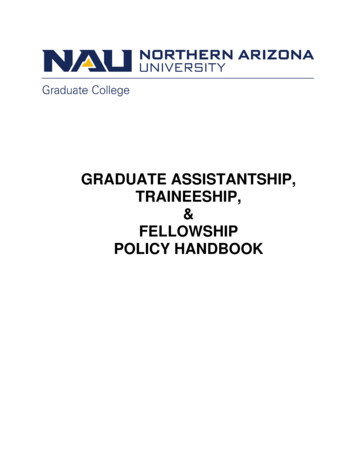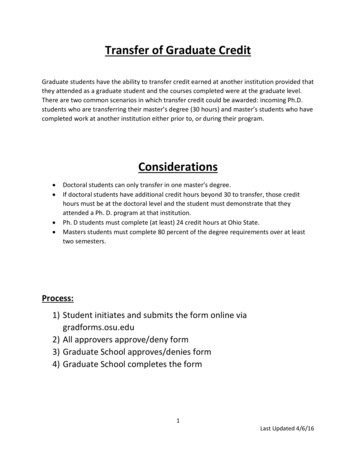
Transcription
F O U R T HE D I T I O NCROSS-CULTURAL PSYCHOLOGYCRITICAL THINKING AND CONTEMPORARY APPLICATIONSEric B. ShiraevGeorge Mason UniversityNorthern Virginia Community CollegeDavid A. LevyPepperdine UniversityAllyn & BaconBoston New York San FranciscoMexico City Montreal Toronto London Madrid Munich ParisHong Kong Singapore Tokyo Cape Town Sydney
Senior Acquisitions Editor: Stephen FrailEditorial Assistant: Kerri Hart-MorrisSenior Marketing Manager: Jeanette KoskinasProduction Assistant: Maggie BrobeckManufacturing Buyer: Renata ButeraCover Designer: Jayne ConteCover Photo: Raycat/Istockphoto.comElectronic Composition: Integra Software Services Pvt Ltd.Copyright 2010, 2007, 2004 Pearson Education, Inc., publishing as Allyn & Bacon, 75 Arlington Street, Suite 300,Boston, MA 02116All rights reserved. Manufactured in the United States of America. No part of the material protected by thiscopyright notice may be reproduced or utilized in any form or by any means, electronic or mechanical, includingphotocopying, recording, or by any information storage and retrieval system, without written permission from thecopyright owner.To obtain permission(s) to use material from this work, please submit a written request to Pearson HigherEducation, Rights and Contracts Department, 501 Boylston Street, Suite 900, Boston, MA 02116, or fax your requestto 617-671-3447.Library of Congress Cataloging-in-Publication DataShiraev, Eric, 1960–Cross-cultural psychology : critical thinking and contemporary applications / Eric Shiraev,David Levy. —4th ed.p. cm.ISBN-13: 978-0-205-66569-3 (alk. paper)ISBN-10: 0-205-66569-1 (alk. paper)1. Ethnopsychology—Methodology. I. Levy, David A., 1954– II. Title.GN502.S475 2010155.8—dc22200804851410 9 8 7 6 5 4 3 2 1 [HAM] 13 12 11 10 09ISBN-10:0-205-66569-1ISBN-13: 978-0-205-66569-3
CONTENTSPrefaceixAcknowledgmentsxiiiChapter 1 Understanding Cross-Cultural Psychology1What Is Cross-Cultural Psychology? 2Basic Definitions 3Culture 3Society, Race, and Ethnicity 4Knowledge in Cross-Cultural Psychology 6Cultural Traditionalism 9Empirical Examination of Culture 11Collectivism and Individualism: Further Research 13Cultural Syndromes 14Evolutionary Approach 14Sociological Approach 15Ecocultural Approach 16The Cultural Mixtures Approach: A New Cross-CulturalPsychology in the Twenty-First Century? 18The Integrative Approach: A Summary 19Indigenous Psychology 21Ethnocentrism 21Multiculturalism 21A Brief History of the Field 22Chapter 2 Methodology of Cross-Cultural Research27Goals of Cross-Cultural Research 28Quantitative Research in Cross-Cultural Psychology 29Quantitative Approach: Measurement Scales 29Quantitative Approach: Looking for Links and Differences 30Qualitative Approach in Cross-Cultural Psychology 31Major Steps for Preparation of a Cross-Cultural Study 32Sample Selection 33Observation in Cross-Cultural Psychology 35Survey Methods 36Experimental Studies 38iii
ivContentsContent-Analysis 38Focus-Group Methodology 39Meta-Analysis: Research of Research 40A Hidden Obstacle of Cross-Cultural Studies: Test Translation 40Comparing Two Phenomena: Some Important Principles 42On Similarities and Differences: Some Critical ThinkingApplications 43Cultural Dichotomies 44There Are Fewer Differences than One Might Think 44There Are More Differences than One Might Expect 45Avoiding Bias of Generalizations 45Know More about Cultures You Examine 47Chapter 3 Critical Thinking in Cross-Cultural Psychology 53The Evaluative Bias of Language: To Describe Is to Prescribe 54Differentiating Dichotomous Variables and ContinuousVariables: Black and White, or Shades of Gray? 57The Similarity–Uniqueness Paradox: All Phenomena Are BothSimilar and Different 59The Barnum Effect: “One-Size-Fits-All” Descriptions 61The Assimilation Bias: Viewing the World throughSchema-Colored Glasses 63The Representativeness Bias: Fits and Misfits ofCategorization 65The Availability Bias: The Persuasive Power of Vivid Events 68The Fundamental Attribution Error: Underestimating theImpact of External Influences 71The Self-Fulfilling Prophecy: When Expectations CreateReality 74Correlation Does Not Prove Causation: Confusing “What”with “Why” 76Bidirectional Causation and Multiple Causation: Causal Loopsand Compound Pathways 79Bidirectional Causation 79Multiple Causation 80The Naturalistic Fallacy: Blurring the Line between “Is” and“Should” 82The Belief Perseverance Effect: “Don’t Confuse Me withthe Facts!” 85Conclusions: “To Metathink or Not to Metathink?” 88
ContentsChapter 4 Cognition: Sensation, Perception, and Statesof Consciousness 93Sensation and Perception: Basic Principles 94How Culture Influences What We Perceive 95How People Perceive Pictures 97Perception of Depth 98Are People Equally Misled by Visual Illusions? 99Some Cultural Patterns of Drawing 100Perception of Color 100Other Senses 103Hearing 103Taste 103Smell 103Touch 104Perception of Time 105Perception of the Beautiful 106Perception of Music 108Consciousness and Culture 109Sleep and Cultural Significance of Dreams 110Beyond Altered States of Consciousness 114Chapter 5 Intelligence120Defining Intelligence 121Ethnic Differences in IQ Scores 123Explaining Group Differences in Test Scores: Intelligenceand Intelligent Behavior 125Do Biological Factors Contribute to Intelligence? 126Incompatibility of Tests: Cultural Biases 127A Word about “Cultural Literacy” 128Environment and Intelligence 129Socioeconomic Factors 130The Family Factor 131“Natural Selection” and IQ Scores 133Cultural Values of Cognition 133General Cognition: What Is “Underneath” Intelligence? 137Classification 137Sorting 137Memory 138v
viContentsFormal and Mathematical Reasoning 138Creativity 139Cognitive Skills, School Grades, and Educational SystemsCulture, Tests, and Motivation 141IQ, Culture, and Social Justice 143And in the End, Moral Values 145140Chapter 6 Emotion 150When We Laugh We Are Happy: Similarities of EmotionalExperience 152You Cannot Explain Pain If You Have Never Been Hurt:Differences in Emotional Experience 154Emotions: Different or Universal? 157Physiological Arousal 157The Meaning of Preceding Events 158Emotion as an Evaluation 161We Are Expected to Feel in a Particular Way 162How People Assess Emotional Experience 163When Emotions Signal a Challenge: Cross-Cultural Researchon Stress and Anxiety 164Expression of Emotion 165When Emotion Hurts: Cross-Cultural Studies of Anger 168Emotion and Inclination to Act 169Emotion and Judgment 169Chapter 7 Motivation and Behavior172A Glance into Evolution 173Social Science: See the Society First 174Drive and Arousal: Two Universal Mechanisms ofMotivation 174The Power of the Unconscious: Psychoanalysis 175Humanistic Theories 176Learning and Motivation 178A Carrot and a Beef Tongue: Hunger and Food PreferenceWhen Hunger Causes Distress: Eating Disorders 179Victory and Harmony: Achievement Motivation 180Aggressive Motivation and Violence 183Culture and Sexuality 188Sex and Sexuality: Some Cross-Cultural Similarities 191178
ContentsChapter 8 Human Development and Socialization 195Development and Socialization 196Quality of Life and the Child’s Development 196Norms, Customs, and Child Care 197Parental Values and Expectations 199Erikson’s Stages of Psychosocial Development 200Piaget’s Stages of Cognitive Development 202Stages of Moral Development According to Kohlberg 203Developmental Stages 204Life before Birth: Prenatal Period 205First Steps: Infancy 206Discovering the World: Childhood 209Major Rehearsal: Adolescence 211Adulthood 214Late Adulthood 216Chapter 9 Psychological Disorders221American Background: DSM-IV 222Two Views on Culture and Psychopathology 223Central and Peripheral Symptoms: An Outcome of theDebate between Universalists and Relativists 225Culture-Bound Syndromes 226Anxiety Disorders 230Depressive Disorders 232Schizophrenia 235Culture and Suicide 236Personality Disorders 239Is Substance Abuse Culturally Bound? 244Psychodiagnostic Biases 246Psychotherapy 247Culture Match? 249Chapter 10 Social Perception and Social Cognition 255Values 256Western and Non-Western Values 258Striving for Consistency: The Cognitive Balance TheoryAvoiding Inconsistency: Cognitive Dissonance 260Psychological Dogmatism 261260vii
viiiContentsSocial Attribution 261Attribution as Locus of Control 262Attribution of Success and Failure 264Self-Perception 266Do Social Norms Affect the Way We See Our Own Body? 267Duty and Fairness in Individualist and Collectivist Cultures 268Stereotypes and the Power of Generalizations 270On “National Character” 272Chapter 11 Social Interaction277Universal Interaction 278Direct Contacts 281Conformity 282Is Conformity Universal across Cultures?Following Orders 288Social Influence 289Feeling Good about Some Views 291Is Social Loafing Universal? 292Cooperation and Competition 292Leadership 293284Chapter 12 Applied Cross-Cultural Psychology: SomeHighlights 299Health 300Spirituality, Science, and Health 303Business Decisions 306Working with Immigrants 309Education 312Culture, Behavior, and the Law 313Human Rights 314Working and Serving Abroad 316Religion: A Campus Context 318Conclusion 319References 322Author Index 352Subject Index 357
PREFACEWelcome to cross-cultural psychology of the Twenty-first century. The field is new andexciting, fascinating in its content, important in its applications, challenging in its goals andaspirations, yet sometimes scarcely able to keep pace with the rapidly changing conditions ofmodern times.Look at the world around us. Previously invincible barriers—both literal andmetaphoric—that have separated people for hundreds, even thousands of years are increasingly cracking, crumbling, and finally collapsing before our eyes. Within a relatively briefperiod of history, the telephone, radio, television, motion pictures, and more recently,computers, e-mail, cell phones, and the Internet are drastically altering our perceptions oftime, space, culture, and each other. One key click and, in an instant, you are virtually on theopposite side of the planet, or even on a different planet.We travel and migrate from one place to another on a scale previously unknown—evenunimaginable—in human history. The United States alone naturalizes almost 500,000 newcitizens and hosts nearly 400,000 international students every year. More and more Europeancountries are moving toward their economic and political unification. Hong Kong has beenreunited with China. From Northern Ireland to Mauritania, from Bosnia to El Salvador,dozens of deadly ethnic, social, and religious conflicts have been stopped and former enemieshave begun to negotiate with one another. Millions of people learn about human rights andpractice mutual tolerance. People understand that they share many common customs, ideas,and hopes. The world is indeed becoming a smaller place.Or is it? Are such optimistic beliefs devoid of factual foundation, resting more onwishful thinking and hope than on empirical evidence? Are we guilty of committing a cognitive error, confusing what “is” with what “ought” to be? While observing the facts about today’sworld, we can contend that the basic differences between cultural groups are, and always willbe, irreconcilable. We can argue that what appears to be “civilization,” “cultural enlightenment,” or “social evolution” is largely illusory. Beneath this perilously thin veneer lurks rawhuman nature: selfish, greedy, and violent. To be sure, some progress has occurred. But manycountries continue to be split along ethnic and religious lines. International terrorism hasbecome a serious problem. Minority groups around the world continue to be ostracized,threatened, and assaulted. Millions of people belonging to various ethnic and religious groupscontinue to be the target of systematic violence. Local politicians reject pleas about humanrights in their countries and label these appeals cultural “expansionism.” Ethnic groups do notnecessarily “blend” together, and the number of intercultural marriages is not on the rise.There is also an undeniable increase in international tensions, acts of terrorism, and ethnicconflicts. Consider the Middle East, Sierra Leone, Timor, Sudan, Iraq, Kashmir, Cyprus . . . isthere any valid reason to believe that the list won’t continue to grow?Even if the world is becoming smaller, what does this mean? To some individuals,“smaller” implies a sense of community, connectedness, and camaraderie. But to others, it istantamount to cramped, crowded, and confining. Where does that leave us and where are weheaded?In searching for answers to questions such as these, we discovered an enormous body oftheories, research, books, journal articles, and Web sites. Upon closer examination, however,ix
xPrefacewhat emerged was not particularly encouraging or even useful: lots of unsupported theories,lots of contradictory findings, lots of defensiveness and emotionally charged posturing, andlots of thinking that was a great deal less than clear.How does one even begin to sort through all of it? Is there a way to separate the proverbial wheat from the chaff? By what means can we thereby make informed decisions?These are some of the questions that we, the authors, have been struggling with for sometime, and, in a nutshell, largely what prompted us to write this book. The background leading toour collaboration is briefly worth noting in several respects. Although we both are of a similarage and share a number of common characteristics (from career choice to taste in music), wegrew up in very different worlds. The first author (Eric) was born and raised in the city ofLeningrad in the former Soviet Union, where he obtained his first academic degrees beforemoving to Virginia. He is a professor, author, and coauthor of 11 books. The second author(David) is from southern California, where he received his formal education and training, andwhere he currently works as a psychology professor, psychotherapist, author, and researcher.Thus, each of us brings a distinctly unique set of experiences and perceptions to thisproject. We were struck by both the similarities and differences in our respective backgrounds,and we sought to utilize these complementary contributions to maximum effect.In discussing our past, we discovered that as we were entering college, neither of us knewvery much about cross-cultural psychology. By the time we started graduate school (Eric atLeningrad State University, David at UCLA), our interest had begun to grow. But the real fascination with cross-cultural psychology emerged much later, specifically when each of usspent an extended period of time teaching in the other’s home country. The appeal has neverwaned and continues to this day.Goals of This Book. We have endeavored to distill and synthesize the knowledge gained fromour own respective educational, research, training, and life experiences into a manageable setof four primary goals. To introduce the field of cross-cultural psychology to college students.To understand contemporary theories and research in cross-cultural psychology.To provide the reader—both instructors and students—with a useful set of criticalthinking tools with which to examine, analyze, and evaluate the field of cross-culturalpsychology in particular, and education in general.To assist current and future practitioners from a wide variety of fields and services.Intended Audiences. This book was designed with the following readers in mind:1. As a primary or supplementary text for undergraduate college students from a diversearray of majors (including but not limited to psychology, sociology, anthropology,education, philosophy, journalism, political science, etc.).2. As a supplementary text for graduate students in areas such as psychology, social work,education, law, journalism, nursing, business, and public administration.3. Clinical psychologists, counselors, and social workers.4. Educators and other practitioners who work in contemporary multicultural environments.Brief Overview. The book consists of 12 chapters. The first two chapters review the key theories,approaches, and research methods of cross-cultural psychology. Chapter 3 introduces principlesof critical thinking and applies these tools directly to topics in cross-cultural psychology byidentifying common errors and providing useful antidotes. Chapter 4 focuses on cross-cultural
Prefaceaspects of sensation, perception, and states of consciousness. The fifth chapter is devoted to theinterface of cross-cultural psychology and intelligence. Chapters 6 and 7 comprise cross-culturalanalyses of emotion and motivation, respectively. Issues related to human development andsocialization are examined in Chapter 8. Chapter 9 focuses on the diagnosis, treatment, and explanation of psychological disorders from cross-cultural perspectives. The topics in Chapters 10and 11 concern cross-cultural accounts of social perception and interaction. Last, Chapter 12identifies several applied problems of cross-cultural psychology.WHAT MAKES THIS BOOK DIFFERENT?Emphasis on Critical ThinkingWe firmly believe that critical thinking is perhaps the most vital and indispensable componentof higher education and learning. Despite widespread consensus on this assertion throughoutthe educational community, however, it has been our experience that specific tools for criticalthinking are rarely, if ever, provided to students during the course of their schooling. In otherwords, people may be convinced of the value of critical thinking, but they are left not knowingquite what to do about it. This book seeks to remedy that dilemma.We view critical thinking as a series of skills that can be successfully taught and learned.As such, we provide the reader with specific strategies, methods, and techniques (along withlots of practice) to achieve this goal. For purposes of this book, each critical thinking principle(“Metathought”) is illustrated primarily from the theory and application of contemporarycross-cultural psychology. Keep in mind, however, that these principles transcend the confinesof any particular topic and can be utilized in a diverse array of fields.In one sense, we use critical thinking to teach cross-cultural psychology; in another, weuse cross-cultural psychology to teach critical thinking. This bidirectional relationship underscores the interdependence between the “content” and the “process” of thinking and learning.Pedagogical Features to Enhance LearningWe have included a wide variety of pedagogical devices throughout the text. Exercises and Activities. There are more than 30 exercises strategically placed throughoutthe book. These can be utilized in any number of ways, including classroom discussions,demonstrations, debates, individual or group take-home assignments, term papers, andoral presentations. Boxes titled “Critical Thinking ” were designed explicitly to providepractice in developing critical thinking skills as they relate to cross-cultural psychology.Chapter Summaries and list of Key Terms appear at the end of every chapter.“A Case in Point” boxes: In some instances, vivid examples or stories are best able tospeak for themselves. A special feature in each chapter reviews and illustrates a numberof controversial issues in cross-cultural psychology, displays cases and research findings,and introduces various opinions about human behavior in different cultural contexts.“Cross-Cultural Sensitivity” boxes: This section—featured in every chapter—presentssome controversial remarks, statements, and actions that underscore the importance ofempathy in interpersonal communications.Quotations: Scores of quotations appear throughout the text. These are intended to servea number of functions, including: to provide divergent points of view; to pique thereader’s interest and curiosity; to utilize humor as a means of facilitating learning; and toxi
xiiPreface induce critical thinking. A sampling of sources includes Dr. Martin Luther King, Jr.,Omar Khayyám, Confucius, Mahatma Gandhi, Lao-tse, Albert Einstein, P. T. Barnum,Vladimir Nabokov, R. D. Laing, Jackie Mason, Miguel de Cervantes, the Bible, andcommon folk proverbs from a variety of cultures (Chinese, Russian, Yiddish, etc.).Vignettes: Each chapter begins with a vignette, a description of a real-life case, situation,or problem related to the chapter’s subject.Website: Additional support for the text can be found on a specially designed websiteat www.ablongman.com/shiraev4e, where you can find practice questions, researchupdates, recent statistics, facts, and links.Test Bank for Instructors.Focus on Applied Contemporary ProblemsWe have dedicated ourselves to making this text as useful, practical, and relevant as possible.As a result, we made it a point to address a variety of applied contemporary themes and topresent cross-cultural analyses for a series of complex problems that society faces today, or islikely to face in both the near and distant future. Throughout, we attempted to strike a balancebetween not making the book too theoretical (and, therefore, not particularly useful in the realworld) or too concrete (which would not cultivate independent thinking).Updates and Changes in the Fourth EditionThis edition of the book is updated with 133 new citations. In particular, there is new researchand theoretical data on traditional and nontraditional cultures, religious identity collectivism,social perception, sleep, trance, beliefs in possession, intelligence, thinking, understandingemotions, violence, physical abuse, sexuality, honor, children’s development, attitudes, verbalcommunications, anxiety and anxiety disorders, mood disorders, culture-bound syndromes,schizophrenia, spirituality, customs, eating disorders, evolutionary psychology, treatment ofpsychological disorders, and acculturation.The book includes new research data obtained on samples from countries such asthe Netherlands, the United States, Russia, Arab countries, India, China, Germany, Canada,Malaysia, Japan, Kenya, Romania, England, Cambodia, Botswana, Brazil, Zimbabwe, Finland,Iceland, Turkey, Austria, Mexico, and Taiwan. There are new data about various immigrantgroups, Muslims, Christians, Native Americans, Arab Americans, Hispanic Americans, andAfrican Americans.Chapters 1, 2, 5, 7, 10, and 12 underwent the most significant rewriting and improvement. There are new topics related to emotions, motivation, social and ethnic stereotypes,therapy, and applied problems.To summarize, we wish to make our own values clear and not to present them as if theywere “facts” or “truths.” We believe that despite all the ethnic, cultural, religious, racial, andnational differences, people can (and in fact should) learn to become more understanding,respectful, and tolerant of each other. Without appearing unduly optimistic, we do have faith inthe enormous potential power of knowledge, reason, and compassion to help realize these goals.It is true that cross-cultural psychology alone cannot solve the profound problemsfacing the human race. However, knowledge coupled with goodwill certainly can create a positive psychological climate that might eventually generate useful solutions. We hope that ourenthusiasm about cross-cultural psychology and critical thinking is contagious and will serveto enhance your own academic, professional, and personal growth.
PrefaceACKNOWLEDGMENTSNo project of this magnitude could have been realized without the invaluable contributions,assistance, and support of scores of individuals. We have benefited from the insightful feedback and advice of colleagues and reviewers, from the diligent efforts of research assistants,and from the patience and understanding of family members and friends. In particular, wewish to acknowledge Tamara Levy, Elizabeth Laugeson, Maykami L. McClure, Beth Levy, JacobLevy, Briana Levy, Zorro Levy, Emma Levy, Dmitry Shiraev, Dennis Shiraev, Nicole Shiraev,Oh Em Tee, Thomas Szasz, Fuji Collis, Don Kilburg, Evangeline Wheeler, Alex Main, SusanSiaw, Gerald Boyd, Vlad Zubok, Elena Vitenberg, Anthony Galitsky, Diana Smith, Mary JoCarnot, Beverly A. Farrow, Bruno Bornet, Yola Ghammashi, Buraq Amin, Janett Chavez, JasonSmith, Sondra Saterfield, Joseph Morris, Judith Farell, William Lamers, Rita Chung, MicheleLewis, Fred Bemak, Vladimir Shlapentokh, Jane McHan, James Sidanius, and VinnieDeStefano.We would also like to thank reviewers, Denis Sukhodolsky, Yale University; Elaine P.Adams, Houston Community College; Karen L. Butler, Johnson C. Smith University; SergeiTsytsarev, Hofstra University; Kevin Chun, University of San Francisco; Fuji Collins, CentralWashington University; G. William Hill, Kennesaw State University; Thomas Hodgson,SUNY-Empire State College; William W. Lambert, Cornell University; Alex Main, MurdochUniversity; Pamela Mulder, Marshall University; Jill Norvilitis, SUNY College at Buffalo;B. James Starr, Howard University; Yvonne Wells, Suffolk University; and Evangeline Wheeler,Towson State University for their insightful comments.A special word of appreciation is due to the administrations, faculty, staff, and studentsat our respective academic institutions (Pepperdine University, George Mason University, andNorthern Virginia Community College), where we have consistently been provided with anabundance of encouragement, assistance, and validation. We also would like to take thisopportunity to acknowledge the tremendous support we received at virtually every stage ofthis project’s development from the team at Allyn & Bacon, in particular, Stephen Frail andKate Motter. On a more personal note, we wish to express our mutual feelings of thankfulnessfor our relationship to each other as collaborators, as colleagues, as comrades, and as friends.xiii
This page intentionally left blank
ber that all things are only opinions and that it is in your power to thinkas you please.MARCUS AURELIUS (112–180 C.E.)—ROMAN EMPEROR AND STOIC PHILOSOPHERThe West can teach the East how to get a living, but the East must eventually beasked to show the West how to live.TEHYI HSIEH (TWENTIETH CENTURY)—CHINESE EDUCATOR AND DIPLOMATHave you noticed that some customs appear more appropriate than others dependingon the country or culture under consideration? A 12-year-old girl named Ana Mariamarried a 15-year-old boy named Birita. Of course, we have heard of arrangedmarriages in Africa and India, but in this particular case the marriage took place in Romania,a European country. Why were so many people outraged about this incident in Romania butremain virtually indifferent to thousands of similar weddings in other parts of the world?Do some customs appear strange to you while others do not? In Sierra Leone, West Africa,during hunting, men do not call each other by name, because they are afraid that the devilsmight learn their names and later harm them. In Morocco, as in many traditional Islamic countries, people believe in demons, or jinni, who possess people’s bodies and abuse their psyches,causing psychological disorders. When listening to these stories, people in Tokyo, New York, orLondon would likely call the idea that demons cause mental illness silly.But why do many people in the West still believe in spiritual charges, magnetism, cosmicenergy, and the evil eye that causes emotional and other problems?Maybe all differences are only in appearance and all people around the world share thesame psychological features that lead to both great and ridiculous decisions. Marina Bai, aRussian astrologist, sued the U.S. National Aeronautics and Space Administration, claimingthat a space probe, which launched a crater into the Tempel 1 comet, had ruined the natural balance of forces in the universe and disrupted Bai’s astrological skills. In Taiwan, a man1
2Chapter 1 Understanding Cross-Cultural Psychologynamed Chen jumped into a lion cage in a local zoo because he heard voices instructing himto do so. Millions of people claim they hear imperative voices. Auditory hallucinations are auniversal symptom of a psychological disorder called schizophrenia. In Hong Kong, peopletoday throw notes attached to oranges into a “wishing tree,” believing that if a thrownwish hooks on to a branch, it will come true. Similarly, almost in every corner of the worldpeople throw coins into fountains, use talismans to guard themselves from physical harm,abstain from certain curses, avoid certain colors, and knock on wood for luck.People’s behavior and beliefs are both similar and different. We are different because wehad different upbringings and resources available to us, learned from different textbooks, atedifferent foods, and pledged allegiance to different flags. We are similar because we are humanbeings who listen, see, feel, act, and share. Cross-cultural psychology seeks to identify andcomprehend both the similarities and differences of people’s behaviors, emotions, motivations,and thoughts across cultures. Most important, this discipline offers the opportunity to connectwith others through a deeper sense of appreciation and understanding.WHAT IS CROSS-CULTURAL PSYCHOLOGY?Before reaching adulthood, most of us do not choose a place to live or a language to speak.Growing up in cities, towns, and villages, no matter where—near a snowy Oslo or in ahumid Kinshasa—people learn how to take action, feel, and understand events around themaccording to the wishes of their parents, societal requirements, and traditions of their ancestors. The way people learn to relate to the world through feelings and ideas affects whatthese individuals do. Their actions, in turn, have a bearing on their thoughts, needs, andemotions.Conditions in which people live vary from place to place. Human actions andmental sets—formed and developed in various environments—may also fluctuate fromgroup to group. These kinds of differences—and of course, similarities—are st
Victory and Harmony: Achievement Motivation 180 Aggressive Motivation and Violence 183 Culture and Sexuality 188 Sex and Sexuality: Some Cross-Cultural Similarities 191 . Chapter 12 Applied Cross-Cultural Psychology: Some Highlights 299 Health 300 Spirituality, Science, and Health 303 Business Decisions 306 Working with Immigrants 309 .










